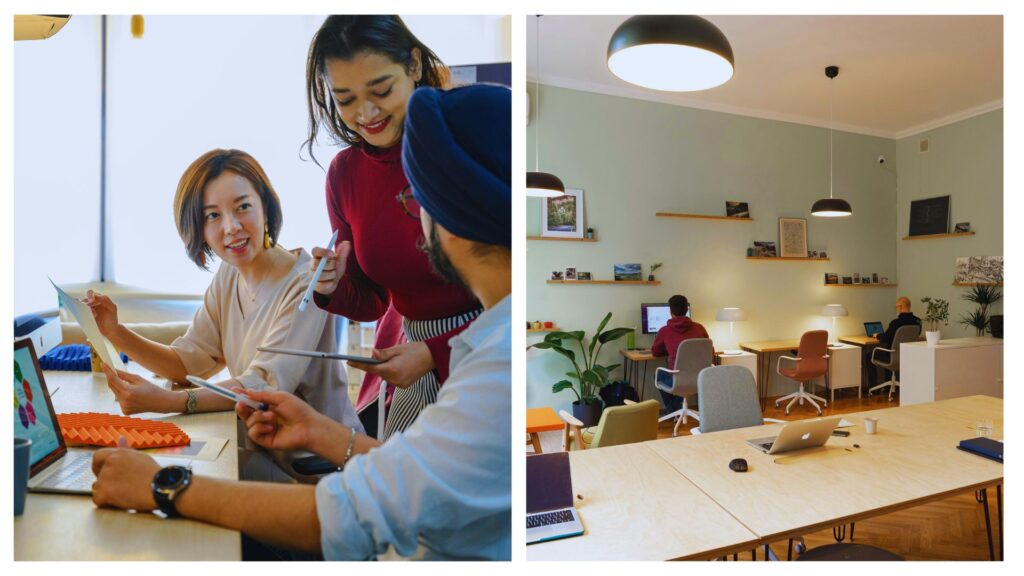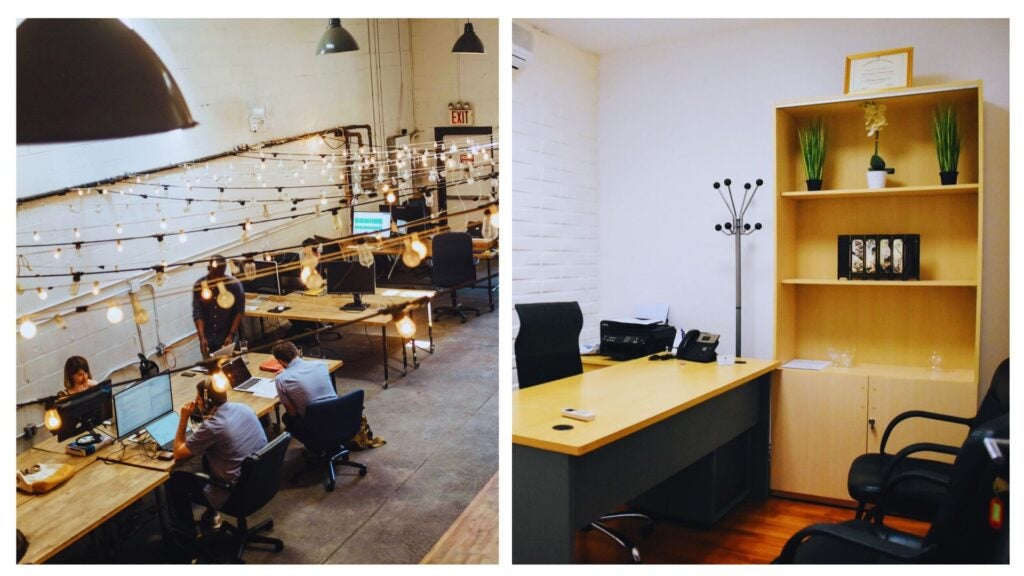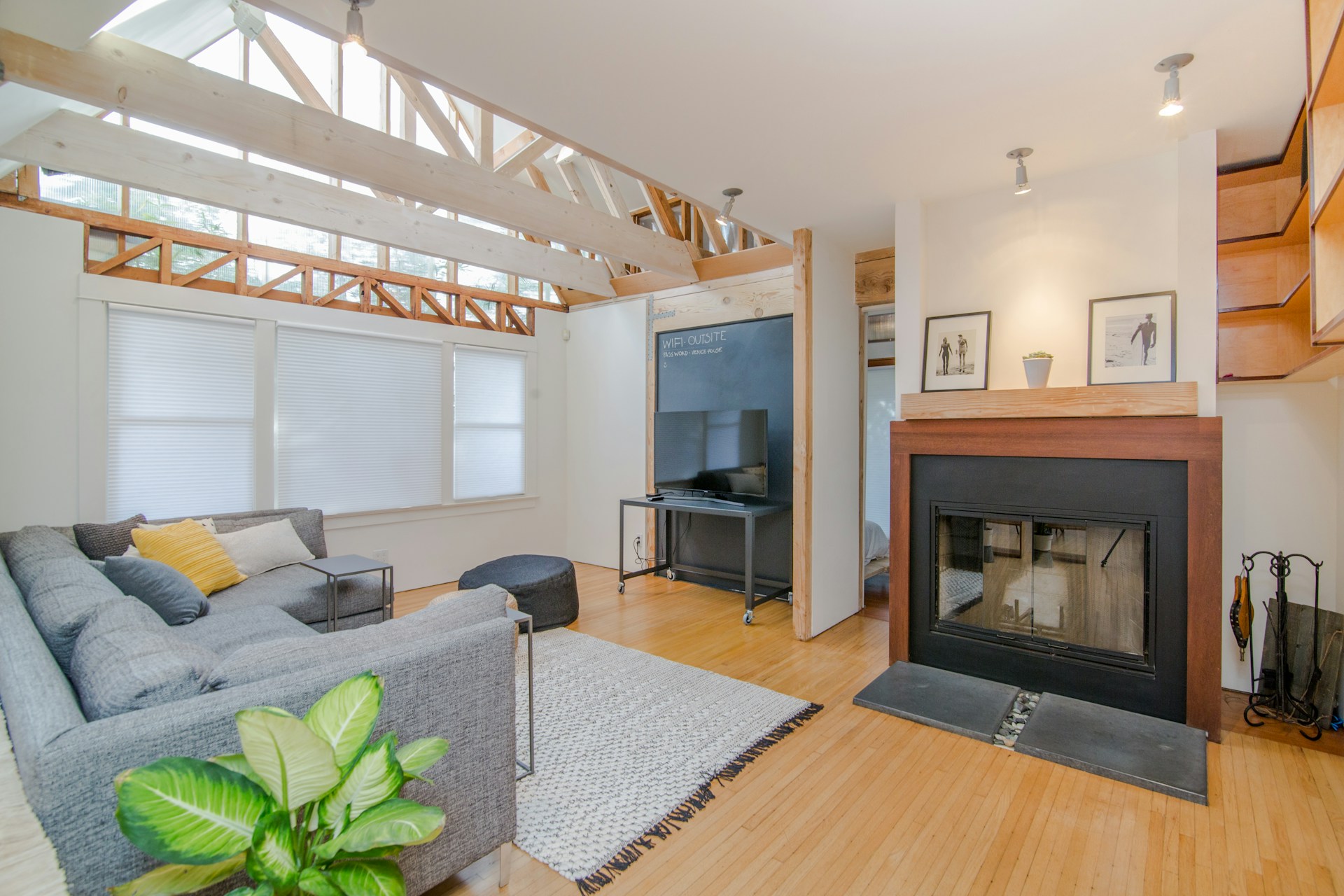What is a coworking space? Meaning, amenities, and activities
What is coworking space? In Holafly we answer this question and go deeper into the services of these spaces and how to book one.
If you’re a freelancer or part of a startup, chances are you’ve heard about coworking spaces. They’ve really taken off alongside the rise of remote work, startups, and the digital nomad lifestyle. In fact, digital nomads have played a big role in putting them on the map—so much so that nowadays, it’s easy to find coworking spaces almost anywhere, offering all the perks of an office no matter where your travels take you.
In this blog, we’ll know what is a coworking space, what makes them unique, the services they offer, and how to rent one. We’ll also take a look at some of the most popular coworking brands around the world—companies that have transformed the way we work and attracted over a million professionals and businesses to their spaces.
What is a coworking space?
A coworking space is a shared work environment where freelancers, entrepreneurs, small businesses, and professionals from different fields come together to get things done. These spaces are built to offer a professional yet flexible atmosphere—whether you need a desk for a few hours or a private office for weeks or months, there’s usually an option that fits your needs.
According to Statista, by 2020 there were already over 19,000 coworking spaces worldwide—and that number was expected to double to more than 40,000 by the end of 2024. In short, small and medium-sized businesses no longer need permanent office locations. And for remote workers and digital nomads, coworking spaces offer a flexible alternative to working from home—or from anywhere in the world.
Unlike a traditional office, a coworking space gives you the chance to connect with other professionals, build a supportive community, and exchange ideas in a more collaborative environment.
What does a coworking consist of?
Common spaces
- Shared work areas: Long tables or individual desks in an open environment. Members can work independently, but in the company of other professionals.
- Meeting rooms: Private spaces equipped for meetings with clients, videoconferences or team sessions.
- Relaxation areas: Usually also have areas for relaxation, such as cafés, lounges or terraces, where users can take a break and socialize.
Services
- Connectivity: High-speed internet access, essential for daily work.
- Equipment: Printers, scanners, projectors and other devices necessary to perform professional tasks.
- Basic services: Supply of coffee, tea, water and, in some cases, snacks for members.
Additional features
- Events and workshops: Several coworking facilities organize continuing education and networking activities among their members.
- Administrative support: Reception services, correspondence handling and administrative assistance.

How does a coworking work?
Coworking spaces are a flexible solution—perfect if you’re an entrepreneur or freelancer who doesn’t need a permanent office just yet, or a digital nomad looking for a desk to catch up on emails for a few hours. While most of these spaces operate in similar ways, pricing and layout can vary. Here’s a general look at how the coworking experience usually works:
1. Registration and booking
If you’re curious about a specific coworking space or want to book one, the best place to start is their website. Most spaces list their pricing and membership plans online, and many even let you reserve a spot directly—whether you need it for a few hours, a day, or an entire month.
2. Joining the coworking
Once you confirm the reservation, you gain access to the space at the chosen time. Some coworking facilities provide access cards or personalized codes to ensure security.
3. Use of services
While you’re there, you’ll have access to the workspaces, meeting rooms, and any other amenities included in your plan. Many coworkings also host events and activities you can join if you’re up for networking or just want to mix things up.
4. Renewal or termination of the contract
As your membership nears its end, you can either renew it or wrap things up—totally up to you. Renewing is usually a quick process and can be done online or by speaking directly with the coworking staff.
5. Abandonment of coworking
If you choose not to renew, you’ll need to clear out your workspace, tidy up your area, and return any equipment or materials provided by the coworking space.

Types of coworking users
We’ve already explained what a coworking space is and how it’s built to serve a wide range of professionals and businesses. That said, there’s a particular group of users who turn to these spaces more often—drawn by the flexibility, sense of community, and vibrant professional atmosphere:
- Digital nomads: Professionals who work remotely while traveling the world. They rely on coworking spaces to give them a stable setup, reliable Wi-Fi, and everything they need to stay productive—no matter where they are.
- Freelancers: Freelancers looking for a professional environment to boost their productivity and build connections. Coworking spaces offer a great alternative to the isolation of working from home, with plenty of chances to collaborate and network.
- Startups: Startups that need flexible, cost-effective spaces to grow their business. Coworking spaces give them access to the infrastructure they need—without the burden of long-term leases.
- Consultants: Consultants who work with clients across different industries often turn to coworking spaces for a professional setting. These spaces offer meeting rooms and a focused environment that’s perfect for client sessions or project work.
- Employees at workation: Professionals who mix travel with remote work. They use coworking spaces to stay productive while exploring new places.
- Remote workers: People who work remotely for a company but don’t need to be in a central office often turn to coworking spaces. It gives them a professional setting, fewer home distractions, and a more structured daily routine.
Why are these spaces popular for digital nomads?
Coworking spaces are a favorite among remote professionals largely because they offer fast, reliable internet—something you can’t always count on in cafés, libraries, or public spots, where connections can be slow. But what if you need high-speed internet throughout your entire trip, even when you’re not at your desk? That’s where Holafly Plans comes in.
With our global plans, you don’t need to:
- Change physical chip.
- Pay expensive roaming services.
Just pick the plan that suits you best, activate your eSIM, and enjoy seamless unlimited data wherever you go. Stay connected with Holafly Plans and leave internet worries behind!
Important: If you are a frequent traveler and want to stay connected without worrying about expensive roaming or looking for a new SIM at every destination, Holafly’s subscription plans are for you. With a single eSIM, enjoy internet in more than 170 countries for a fixed price and no surprises on your bill. Travel without limits and connect easily and securely! 🚀🌍

How to hire or rent a coworking space?
Coworking spaces are designed to be flexible and user-friendly—and the process of getting started is just as simple. Whether you’re on a tight budget or looking for something more premium, most spaces offer quick, hassle-free ways to get set up. That said, there are a few common steps and requirements to keep in mind.
Types of membership
- Flexible workstations: Access to shared work areas with no fixed desk assignment, for those who do not need a permanent space.
- Fixed workstations: Specific desk assignment for those who require greater stability and personalization of the workspace.
- Private offices: Closed spaces for teams or companies that require greater privacy.
- Hourly or daily access: For users who need the space on an occasional basis.
Requirements
- Registration: Complete a form with personal and professional data.
- Payment: Pay the corresponding fee for the selected plan, which may be monthly, quarterly or yearly.
- Use agreement: Sign a contract that establishes the rules of the space and the conditions of the service.
Hiring methods
- Plan selection: Choose the type of membership that best suits your work needs.
- Visiting the space: Many coworking facilities offer tours to get to know the facilities before making a decision.
- Registration and payment: Complete the registration and make the payment through online platforms or at the coworking reception.
- Access: Once the above steps are completed, the user is provided with access to the space and contracted services.
Note: Meeting rooms, networking events and workshops may not be included in the membership and may have an additional cost.
Most popular coworking spaces and companies
“What is a coworking space?” It’s a question that comes up more and more these days. These flexible workspaces let you rent a desk or private office just for a few hours if that’s all you need. They’re comfortable, well-equipped, and a serious upgrade from trying to work out of a café or noisy public spot.
In this section, we’ve rounded up a selection of companies that specialize in providing fully equipped temporary workspaces. They’re designed to help professionals stay productive and can be found in cities all over the world.
According to Statista, companies like WeWork and Regus are leading the shared office space market. In 2018 alone, WeWork generated over $1.5 billion in revenue, while Regus holds the top spot in terms of global reach, offering coworking spaces in over a thousand cities around the world.

1. WeWork
WeWork is one of the most iconic names in the coworking world. Founded in 2010, it has expanded to countries like the U.S., UK, Japan, Australia, and Mexico. What sets WeWork apart is its sleek, modern design and a strong sense of community that encourages collaboration among members. They offer everything from desks to fully private offices.
2. Regus
With over three decades of experience, Regus has become a go-to provider for flexible office solutions—offering coworking spaces, private offices, and fully equipped meeting rooms. Today, the company operates more than 3,000 workspaces across 1,000+ cities in 120 countries around the world.
3. The Hive
Founded in Hong Kong in 2012, The Hive has become a popular choice for creatives and entrepreneurs alike. It offers private offices, dedicated desks, meeting rooms, relaxed common areas, high-speed internet, and regular community events. It operates 23 locations across six Asia-Pacific countries, including Australia, Singapore, Hong Kong, Thailand, Vietnam, and Taiwan.
4. Spaces
Spaces was founded in Amsterdam in 2008 and has grown into a global coworking brand with over 400 locations worldwide. You’ll find their spaces in countries like the U.S., UK, Germany, France, Italy, Spain, Australia, Japan, China, India, Mexico, and Brazil. They offer everything from shared desks to private offices, along with high-speed internet, meeting rooms, vibrant common areas, and regular community events designed to foster connection and creativity.
History and evolution of coworking
Coworking has transformed how professionals and companies approach work—offering shared spaces that encourage collaboration, flexibility, and a fresh take on the traditional office.
The term “coworking” became widely known in the 2000s, but its origins go back to collaborative work initiatives in the ’90s. One of the earliest examples was “C-base,” founded in 1995 in Berlin—a community space where people with shared interests in tech and computing could come together and work under one roof.
Progress and changes over the years
On August 9, 2005, Brad Neuberg launched what’s considered the first official coworking space—“San Francisco Coworking Space”. His idea was to blend the freedom of working independently with the structure and sense of community you’d find in a traditional office. From there, the coworking concept took off globally. Companies like WeWork, founded in 2010, played a major role in making these spaces mainstream.
Today’s coworking spaces have evolved to keep pace with the changing demands of the modern workforce. Many now integrate emerging technologies to enhance the user experience and offer hybrid models that blend physical workspaces with virtual solutions.
Alongside these changes, there’s a growing trend toward building strong business communities. Many coworking spaces now host events, workshops, and networking activities that encourage collaboration and connection among their members.
In short, what began in the ’90s as an innovative concept has, by 2025, evolved into a key part of the global work landscape—shaped by professionals, businesses, and a world that never stops changing.
Frequently asked questions about coworking spaces
No, although both concepts share the idea of shared spaces, they have different approaches:
–Coworking: Spaces designed for working, with services and infrastructure for professionals and companies.
–Coliving: Shared housing where residents share common areas, and sometimes also workspaces.
-Desks and private offices.
-Equipped meeting rooms.
-High speed Internet access.
-Common areas such as cafeterias and lounge areas.
-Additional services such as printing, networking events and 24/7 access.
–Digital nomads: Professionals who work while traveling.
–Freelancers: Independent workers who are looking for a professional environment.
–Startups: Small teams that require flexible spaces.
–Remote employees: People working outside of traditional offices.
1. Selection of the appropriate space and plan (by hours, days, weeks or months).
2. Registration and payment of the membership.
3. Access and use of the space according to the contracted conditions.
-Flexibility to work in different locations.
-Reliable infrastructure, such as fast internet and convenient access.
-Opportunities to meet other professionals and expand networks.
–Coworking: Shared spaces, flexible, with short contracts and services included.
–Traditional office: Private space, with longer contracts and less flexibility.





 Language
Language 


















 No results found
No results found







